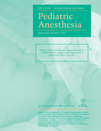A comparison of three methods that assess tracheal tube leakage: leak conductance, fractional volume loss, and audible assessment
Abstract
Background
When intubating a child's trachea with an uncuffed tracheal tube (TT), it is current practice in anesthesia and intensive care to use the leak test to assess TT fit. The aim of this study is to compare three measures of assessing leak around uncuffed tracheal tubes in the PICU.
Methods
We obtained institutional ethical permission and written informed consent, prior to any clinical investigation, from the parents of 135 children who had surgery for cardiac defects. On admission to the PICU, we measured leak by audible assessment, fractional volume loss, and leak conductance for each patient. Measurements of fractional volume loss and leak conductance were repeated every 4 h thereafter until extubation.
Results
On admission to the PICU, calculated values of leak conductance were significantly different between each grade of audible leak (P < 0.001). Values of fractional volume loss were not significantly different between ‘no leak’ and ‘small leak’ grades of leak. Throughout the PICU stay, a significant correlation between mean leak conductance and mean fractional volume loss was found (0.86, 95% CI, 0.81–0.90). Significant agreement within time series of leak conductance and fractional volume recorded for each patient occurred in 47/128 cases (37%).
Conclusions
On admission to the PICU, values of leak conductance are more strongly associated with audible assessment than with fractional volume loss. Throughout PICU stay, leak conductance is associated with fractional volume loss. This study demonstrates that leak conductance, calculated from routinely available pressure and flow signals, has the potential to represent the characteristics of the leak interface between a TT and the trachea.




